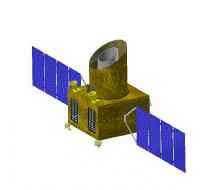Eddington F2/F3 mission - background information
 Key objectives and payload
Key objectives and payload
The key objectives of Eddington are to understand the physical processes that govern the evolution of stars of different types and ages, and to search for and determine the characteristics of Earth-like planets orbiting other stars. The first objective uses asteroseismology, the only method that effectively allows us to probe the interior structure of stars. While the second objective makes use of "transits", or dips in the light curve, in front of the parent star, to detect Earth-size planets. Both objectives will be achieved with the same payload, a wide-field 1.2 m triple reflection optical telescope and associated CCD camera yielding high-accuracy long photometric time series for a large number of stars in the field of view.
The Eddington spacecraft in its deployed, observing configuration.
 Mission design
Mission design
The Eddington assessment study, completed in early June, has resulted in a mission design based on a standard European platform (PRIMA), needing only minor modifications. The use of a standard platform is advantageous in terms of industrial cost and project schedule. The payload, consisting of the telescope, the camera and a stray light baffling system, is to be partially embedded into the service module to ensure the best mechanical accommodation and stable thermal environment. The lift-off mass will be about 1200 kg. The operational orbit, of the Lissajous type, which is an eclipse-free orbit around the lagrangian point L2 of the Sun-Earth system, will be reached in about 100 days with direct injection by a Soyuz-Fregat launcher from Baikonur.

